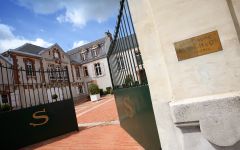Salon Blanc de Blancs Le Mesnil 1999
-
Robert
Parker



Product Details
Your Rating
Somm Note
Winemaker Notes
The 37th and last vintage of the 20th century. A very pale yellow with barely green hints and a lively but discreet nose, the 1999 Salon has a youthful grace that captures the palate, firm and textured. Brioche, white bread, white blossom, white fruit and bitter almond flavors are still developing. The middle palate is crystalline and it has a lingering finish with hints of citrus.
Delicacies to accompany the 1999 Salon: warm oysters and caviar, a lightly cooked sea bass with a truffle risotto, or sweetbreads with morel mushrooms. An excellent Parma or Iberico ham, a well-aged Parmesan cheese, or simply by itself with grilled almonds.
Professional Ratings
-
Robert Parker's Wine Advocate
The Salon 1999 Brut Le Mesnil – disgorged already in 2011 and dosed with a pretty typical six grams of residual sugar – displays faintly fusil and quarry dust notes as well as hickory nut, almond, walnut and toasted wheat piquancy on the nose. Polished and subtly creamy in texture yet brightly juicy with apple and lemon, this displays an uncanny sense of lift and refinement, perfectly complementing the honeysuckle and heliotrope perfume that waft inner-mouth. You could lose yourself in the ineffability of this wine’s floral diversity and in its resonantly nut and grain low tones. Hints of apple pip lend subtle additional piquancy on a long and at once soothing as well as stimulating finish, with suggestions of oyster liquor becoming prominent as the bottle stands open for a few minutes, and serving to milk the salivary glands for all that they are worth. Follow this for at least a decade.
Other Vintages
2013- Vinous
-
Jeb
Dunnuck -
Robert
Parker -
James
Suckling - Decanter
-
Wine
Spectator
-
Robert
Parker -
James
Suckling -
Wine
Spectator
-
Wine
Enthusiast -
James
Suckling -
Robert
Parker -
Wine &
Spirits -
Wilfred
Wong -
Wine
Spectator
- Decanter
-
Wine
Spectator -
Robert
Parker
-
Wine
Enthusiast -
James
Suckling -
Robert
Parker -
Wine &
Spirits -
Wine
Spectator
- Decanter
-
Wine
Enthusiast -
Wilfred
Wong -
James
Suckling -
Wine
Spectator
-
Connoisseurs'
Guide -
Wine &
Spirits -
Wine
Enthusiast -
Robert
Parker -
Wine
Spectator
- Decanter
-
Robert
Parker -
James
Suckling -
Connoisseurs'
Guide -
Wine
Enthusiast -
Wilfred
Wong -
Wine &
Spirits -
Wine
Spectator
-
Wine
Spectator
- Decanter
-
Robert
Parker
-
Wine
Spectator -
Wine
Enthusiast
-
Wine &
Spirits -
Wine
Enthusiast -
Robert
Parker -
Wine
Spectator
-
Robert
Parker




Salon is a unique Champagne. All the emphasis in the production of this exceptional wine is on the singular. It was originally the product of one single man, Aimé Salon; from one single region, the Côte de Blancs; from one single cru, Le Mesnil-sur-Oger; from one single grape variety, Chardonnay; and from one single vintage, with no blending whatsoever. Created in 1911 with its first vintage in 1905, Champagne Salon is the creation of Aimé Salon, a champagne connoisseur enchanted then seduced by the terroir of Le Mesnil. After World War I, he was encouraged by his numerous friends to profit more fully from his wine and the house of Salon was created to cater to his new clientele. Headed by Salon until his death in 1943, the house was then left to his nephew. In 1988, Champagne Laurent-Perrier, a family-owned company, became the majority shareholder of Champagne Salon. Today, the house of Salon, along with its ancient neighbor and sister, Champagne Delamotte (the 5th oldest Champagne house, founded in 1760) are directed by one man, Didier Depond.
